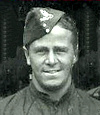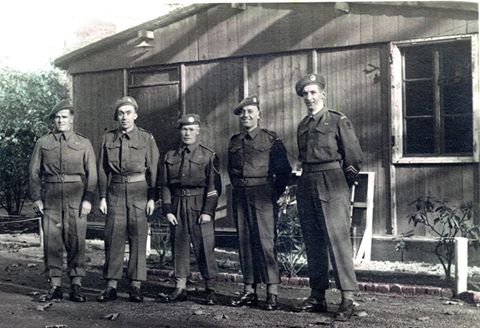|
Private Arthur Moore
58th Battalion Northamptonshire Regiment
Germany and the race to Lűbeck to stop the Russians
occupying Denmark
14th April - 8th May 1945 VE-Day

14th April 1945
Private William Arthur Moore was transferred to the Northamptonshire Regiment part of 21st Army Group as more manpower was needed for the move into Germany. Unfortunately Arthur’s Army Record does not show which battalion of the Northamptonshire Regiment he was posted to. My hunch is that he was posted to the nearby 58th Battalion Northamptonshire Regiment as they arrived near Arnhem on the 15th April 1945 just before advancing into Germany. His skills as a gunner may have been required for the 58th Battalion Anti Tank Support Company. The other battalion the 4th Battalion Northamptonshire Regiment spent the next two months behind the front line on the Rhine

15th April 1945
The 58th Battalion Northamptonshire Regiment arrived in Goch just south of Nijmegan across the German Boarder by train from a holding position in Ghent, Belgium. From there they advanced towards the River Elbe. On 22nd April 1945 the Battalion were involved in the clearance of a portion of the forest of Gohrde in which they encountered only slight opposition and took a few prisoners. The town of Katemin was captured without difficulty and no casualties. Positions were taken up to the west of the town and patrols were sent out to the River Elbe but with no enemy contact.
After a few days on the defensive, which was uneventful except for the enemy shelling which followed two deception attacks, the 58th Battalion was relieved by an American unit and moved back in readiness to exploit the success of the crossing of the river farther to the north by the 15th Division.
1st May 1945
The 58th Battalion Northamptonshire Regiment was the reserve Battalion to 17th Brigade for Operation Volcano for the advance to Lűbeck on the Baltic Coast in North Germany. They started to move off at Midnight but there was considerable delay owing to the number of vehicles waiting to cross the river Elbe. By noon the 58th Battalion had concentrated to the north of the river and began to move on in convoy. They did not meet any resistance apart from an attack by a single German aircraft which wounded two British soldiers. They were the last casualties of the war in the 58th Battalion. They delayed again waiting for the surrender of the 245th Infantry Division of the German Army. Because of the large amount of prisoners two of the 58th Battalion's companies , 'C' and 'D', had to stay behind to deal with them.
2nd May 1945
The 58th Battalion had reached Lűbeck by morning after a fast road journey. Lűbeck was occupied without resistance. The reason for the mad dash was to prevent the Russians adding Denmark to there new empire. By 3pm the battalion has started to set up camp at Travemunde on the Baltic coast. They were relieved by the 11th Armoured Division.
3rd - 5th May 1945
The 58th Battalion spent most of these three days shepherding thousands of surrendering German soldiers of all ranks and ages. They also had to send out patrols. The Support company captured the secretary of Heinrich Himmler leader of the SS whilst out on patrol. On 4th May the music on the radio stopped and the announcer said that the Germans had surrendered and that all fighting had stopped. For a moment there was complete silence then all hell broke loose. The soldiers all hugged each other and shook hands then out came the beer and wine that they had saved and liberated over the recent months.
6th May 1945
The 58th Battalion moved back to the old port of Lűbeck. They were given the job of guarding fuel dumps and keeping order.
8th May 1945 - VE-Day - Victory in Europe day.
The German surrender, was duly celebrated by the men of the 58th Battalion Northamptonshire Regiment in and around Lűbeck. Representatives attended the Victory in Europe Parade at which the Divisional Commander took the salute. They stayed on in Germany and became part of the Army of Occupation.
4th Battalion Northamptonshire Regiment
The Allied forces had begun to cross the Rhine south of the Dutch border on the 23rd March 1945. Within a week the industrial area of the Ruhr had been encircled. The Americans were streaming eastwards into Germany and the British were heading North Eastwards towards the Baltic coast. The power of the German armies to mount a proper resistance had been broken. Their final defeat was near. As the Allied advance moved swiftly towards the interior of Germany there was much work to be done by troops who remained on the Rhine. Arthur may have been posted to this battalion but I think it unlikely as he was a skilled gunner and would have been better used on the advance into Germany with the 58th Battalion. The 4th Battalion Northamptonshire Regiment found the daily round of work did not lack variety. There were many bridges and ferries that needed guarding mainly to prevent the unauthorised movement of civilians across river. They were also tasked with maintaining the security of 160 square miles of land assigned to 1st Corps District. This involved many jeep patrols to search for stock piles of firearms and food in houses, farms and barns. The battalion’s Pioneer Platoon began clearing dumps of mines in Reichswald which is just inside Germany south east of Nijmegan. Soldiers also had to guard a 25 mile long ammunition depot in Holland and various supply depots which were targets for thieves. ‘C’ Company had to stop disorder between Russian labourers, Italians and German civilians. The battalion also ran a training camp in various subjects for the 2nd North Brabant Regiment of the reformed Dutch Army.
Post World War 2 Army of Occupation.
6th February 1946
Proceeding UK for Class ‘A’ release. Striked off strength BAOR. Embarked from North West Europe for the UK. On the same day Disembarked from over seas and posted to Y list (E) The following remarks were written on his release papers at No 3 Military Disembarkation Camp Unit Shorncliffe. Trade on enlistment Cabinet fitter. Military Conduct was very good. This man has served five years with the army and the last few months with this unit. His work and conduct whilst with this unit has been above reproach. Dated 29th January 1946 Mons Germany Major J Sewwall 4th battalion the Northamptonshire Regiment. Permanent address 75 West Hill, Putney
Several battalions are grouped to form a regiment or a brigade. An infantry battalion is numbered ordinarily within its regiment (e.g. 1st Battalion, The Rifles, usually referred to as 1 Rifles). It normally has a Headquarters Company, Support Company, and three Rifle Companies (usually, but not always, A, B and C Companies). Each company is commanded by a Major, the Officer Commanding (OC), with a Captain or senior Lieutenant as Second-in-Command (2i/c). The HQ company contains signals, quartermaster, catering, intelligence, administration, pay, training, operations and medical elements. The support company usually contains anti-tank, machine gun, mortar, pioneer and reconnaissance platoons.
|

